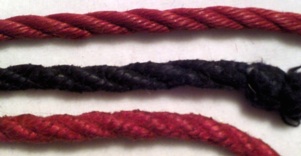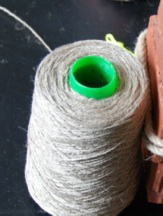Choosing the fibre

This page will deal with the most commonly used fibres :jute, hemp and flax.
Jute
Jute rope is made from either White Jute (Corchorus Capsularis) or Tossa Jute (Corchorus Olitorius), also known as “Golden Jute”.
N.B. This doesn’t automatically mean that all white-looking jute ropes are made from White Jute, as Golden Jute can be bleached. The bottom rope in the photo below is made from bleached Golden Jute:
Jute is light; an average 6 mm diameter rope of 8 m weighs about 110 to 130 g.
Hemp
Hemp fibres are very long (from about 1 m to more than 4 m, depending on the plant stem length), yet standard hemp ropes bought in marine shops, garden centers, DIY stores etc. don’t reflect that characteristic, as shown in the photo below. This is because, considering their purpose and intended uses, that kind of rope is not made from the longest, higher quality fibres. When longer fibres are used, the surface of hemp ropes isn’t as rugged as what the photo shows.
The weight of my 6 mm, 8 m long hemp ropes is slightly above 200 g.
Flax
Flax fibres are shorter than those from hemp (less than 1 m), but when good quality material is used to make ropes, those look smoother than standard hemp ropes, although they don’t have the natural smoothness of jute.
While flax is very similar to hemp, ropes made with either fibre feel different. Flax ropes tend to feel “cooler” to the touch. They also absorb water, and more generally humidity to a greater extent than hemp.
One of the main differences between flax and the other natural fibres is that flax is stronger when wet, while hemp and jute ropes are weaker when wet than when dry.
To go back to “Steps”, click here
To go back to “Rope-Making”, click here



Top rope: jute
Bottom ropes: hemp

Hemp ropes made with yarn such as the one shown on the left have a smoother surface and look much more like jute ropes.
That yarn used to be used by the food industry before being replaced by synthetic materials, hence its high quality and fineness - once used to tie up roasts, now upgraded to tying live humans ;-)
For tips to identify fibres, click here